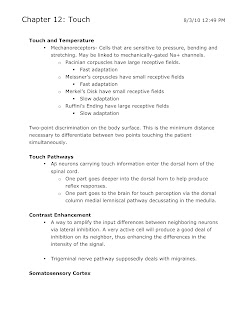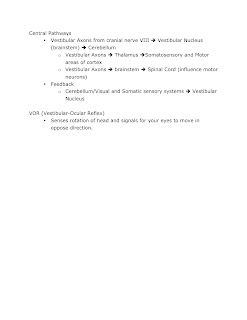Hey Hey!
So these are the questions from today's review session Jeopardy game. If you guys have any questions regarding the material, don't hesitate to email me. I will be in MacMillian at 10:30am if you guys want to go over last minute questions and what not.
Exam Information: MacMillian Hall (across from Science Library) from 1pm-4pm
Good luck studying! See you tomorrow
Chris
These are the basic tastes
Salt
Sour
Sweet
Bitter
Umami
Definitions of:
Ageusia
Hypogeusia
Dysgeusia
Ageusia: Loss of taste
Hypogeusia: Partial loss of taste
Dysgeusia: Distortion of sense of taste
We have ____ (#) olfactory receptors.
How do we detect more than ____ different smells?
900 Different Olfactory Receptors
Population Coding
Taste signals pass through the _______ before reaching the cortex
Thalamus
Describe the difference in olfactory CNS processing compared to other sensory input
Signals can go through the thalamus to the neocortex (frontal lobe), and can also go DIRECTLY to the olfactory cortex (temporal lobe), bypassing the thalamus.
Describe the function of the following: Pupil, Iris, Lens, Cornea, Sclera, Vitreous Humor, Retina
Pupil: Allows light to strike retina
Iris: Contains muscle to contract pupil
Lens: Help focus images
Cornea: Bends light to converge on retina
Sclera: Wall of eyeball
Vitreous Humor: Viscous, maintains shape
Retina: Contains photoreceptors
Define the following eye disorders
-Strabismus: (Esotropia and Exotropia)
-Cataract
-Glaucoma
-Detached Retina
-Retinitis pigmentosa
-Macular degeneration
Strabismus: Lack of coordination of the eyes. Esotropia: Gazes cross (cross-eyed) Exotropia: Divergent gazes.
Cataract: Clouding of the lens.
Glaucoma: Intraocular pressure ® optic nerve damage
Detached Retina: Retina detaches from the wall of the eye.
Retinitis pigmentosa: Loss of photoreceptors, peripheral vision lost 1st
Macular degeneration: Central photoreceptors lost 1st
Describe the sequence of events that occurs in the photoreceptors of the retina from the time that light hits the retina up to and including the bipolar cell response.
In the dark, cGMP activates sodium channels to produce some depolarization in the photoreceptor cells. This in turn causes some glutamate release onto the bipolar cells. The bipolar cell could be depolarized or hyperpolarized by this action. If the bipolar cell contains AMPA receptors it will be depolarized, and then it will be characterized as an OFF bipolar cell (more depolarized when the light is off). If the bipolar cell contains a G-protein coupled glutamate receptor it will be hyperpolarized by glutamate, and then it will be characterized as an ON bipolar cell (more depolarized when the light is on).
When light strikes rhodopsin, the retinal changes shape, which produces a conformational change in the rhodopsin. This in turn will activate a G-protein (transducin) to activate a phosphodiesterase enzyme that will break down the cGMP. This causes the photoreceptor cell to hyperpolarize (less sodium channels open), and release less glutamate. The bipolar responses are indicated above.
Describe Ocular Dominance Shift
This shows plasticity in the visual system. You can record in the visual cortex to see responses from left eye and right eye, and get a normal distribution. You can then (in an animal study) suture one eye closed, say the left eye. After a certain period of time, you can remove the suture and do the visual cortex mapping study again. You find that now there is a dramatic shift in responsiveness, such that the right eye dominates. There is a certain critical period of time during development where this response is maximal. This has implications for conditions such as lazy eye, which can be corrected at a young age by patching the good eye 6 days a week to make the weaker eye work and establish its responsive area in the visual cortex.
Describe the visual pathway starting with the photoreceptor and ending in the Temporal and Parietal Cortex
Photoreceptor
Bipolar Cell
Ganglion Cell
Optic Nerve
LGN
Primary Visual Cortex
Temporal and Parietal Cortex
External fluid in the inner ear contains high concentrations of this
Potassium
Describe the pathway to the CNS starting with outer ear and ending with Primary Auditory Cortex (A1)
Outer Ear
Middle Ear (Ossicles)
Inner Ear
Brain Stem
MGN
A1
Describe both Horizontal and Vertical sound localization
Horizontal: Both ears working together, interaural time delay
Vertical: Uses convolutions in pinna.
Describe functions of the Vestibular System
Sense of Balance
Sense of Position and Movement of Head
Coordinating Movement of Eyes
Why are drugs such as furoemide (a diuretic) and gentamicin (an antibiotic) especially dangerous
These drugs are ototoxic and their effects can be synergistic. They harm the outer hair cells and prevent normal amplification of sound.
List and then describe the characteristics of the different primary afferent neurons
Aα myelinated, fastest, proprioception
Aβ myelinated, fast, mechanoceptors
Aδ myelinated, Slow, pain/temp
C non-myelinated, Slowest, pain/temp/itch
Chemicals released from damaged tissue that can produce nocioception
Prostagandins, Histamine, Bradykinin, Substance P
Characterize Meissner, Pacinian, Merkel, and Ruffini Receptors in terms of receptive field size and adaptation
Meissner: Fast, Small
Pacinian: Fast, Large
Merkel: Slow, Small
Ruffini: Slow, Large
Touch signaling to the brain uses the __________ pathway
Dorsal Column Medial Lemniscal Pathway
____________ can amplify differences between input from neighboring neurons
Lateral Inhibition
The alpha motor neuron and all of the muscle fibers it innervates
Motor Unit
Compare Fast and Slow Muscles
1)Fast: White, Fast contraction, fatigue easier
2)Slow: Red, Slow contraction, do not fatigue as easily as white muscles.
Muscle contraction is triggered by the release of ____ from the motor neuron onto the muscle receptor
Acetylcholine
These innervate muscle fibers (intrafusal) that are within the muscle spindles and provide info about muscle length
Gamma Motor Neurons
Describe the steps of contraction in a muscle
Ach Release è Stimulate nicotinic muscle receptors
EPSP produced
Depolarization stimulates sarcoplasmic reticulum to release Calcium
Calcium binds to troponin
Allows myosin to interact with actin
Myosin heads pivot, causing contraction
ATP disengages actin/myosin
Area 6 in the fontal lobe is associated with _____
Motor Planning
Degeneration in the basal ganglia causes
Parkinson’s Disease
Pathway important for executing planned movement and for learning motor tasks
Corticopontocerebellar Projection
Movement direction is encoded by the collective activity of _______
A population of neurons
(population coding)
Describe the causes of:
Parkinson’s
Huntington’s
Ballism
Parkinson’s: Loss of DA input to putamen (hypokinesia)
Huntington’s: Loss of GP inhibition of Thalamus
Ballism: Loss of subthalamic activation of GP
Describe 3 examples of plasticity in the Nervous System
Auditory (localization)
Visual (Ocular Dominance)
Sensory Cortex (Mouse Whiskers)
Motor Cortex (Monkey Fingers)















